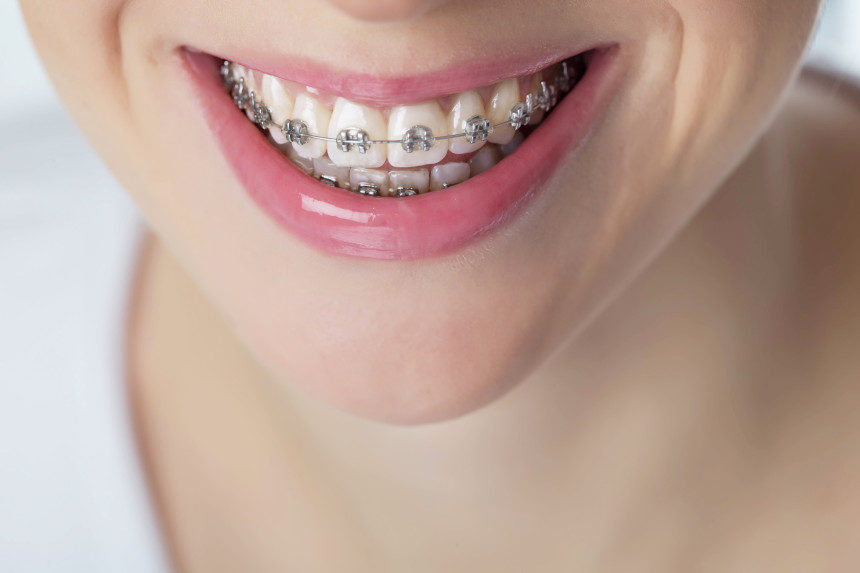In the 2018 movie Bohemian Rhapsody, young Freddie Mercury tells his fellow musicians that he’d like to join their band. “Not with those teeth, mate,” they laugh. The shame on Freddie’s face hit me in the gut.
My friends who saw the film barely remembered that moment. Nor did they notice how the adolescent Freddie was constantly pulling his top lip over his teeth or covering his mouth with his hand. For me, that was the story. My story.
It took me back to ninth grade on Long Island, when I heard giggling as I walked onto the school bus. I bounced into my usual seat and asked a classmate what was so funny. Nodding toward a group of the seniors, she whispered, “They were laughing about your teeth.” I felt I could barely breathe, that the world was in on a sneaky secret: my smile was gross. I felt like a freak.
My father, an Italian immigrant knife sharpener, earned just enough for a home in a blue-collar neighborhood and Catholic-school tuition. Our dentist was a sole practitioner who pulled teeth and filled cavities from his home office three blocks from my school. There was no dental insurance. My parents paid cash. When I asked about braces, my mother said, “When you get married, your husband can pay for it.”
When I asked about braces, my mother said, “When you get married, your husband can pay for it.”
Unlike Freddie, I didn’t have four extra incisors. I had what is known as a “high protruding cuspid.” It was a long pointy tooth just off center, aka an eye tooth, canine or, as kids liked to tease, a fang. Cuspids emerge in middle school. Similar to wisdom teeth, they can be impacted if there aren’t braces holding the space open. My two front teeth also overlapped in an overbite, but it was the Dracula tooth that mortified me.
Over the years, I’d practice smiling without showing my teeth. My mother would remark at how my two younger sisters were more photogenic. Their little choppers weren’t perfect, but they had no need to hide. I was the only one with a grotesque tooth sticking out.
After college, earning a paycheck, I didn’t look into braces right away. As much as I hated my gargantuan eye tooth, I was afraid a mouth full of metal would make it harder to be taken seriously on the job as a cub reporter at an upstate newspaper.
Once, during a dental checkup, I asked about a new method involving tiny invisible braces that clipped to the inside. The dentist warned it might not work with my teeth, and when he told me the price was $1,700, I knew I couldn’t roll the dice on three months’ take-home pay.
In my mid-20s, my fiancé’s upper-middle-class parents threw us an engagement party at their home. A dentist they invited told me, “You’re such a pretty girl; I’d love to see you do something about your teeth.” I was hoping he would offer to do it inexpensively, but he didn’t. In our wedding pictures, I have a Mona Lisa smile that looks fake.
During our marriage, my husband’s term of endearment for me was “Snaggle Tooth.” He thought it was funny. I thought it was cruel. With a mortgage and his small salary as a young lawyer, the cost of braces was a year’s preschool tuition for our two children.
When my son and daughter reached middle school, I took them to the orthodontist. As a mom, I was determined to do better for my kids than my parents had done for me.
By this time, I was separated, soon to be divorced. While I wasn’t rolling in cash, I had a full-time job in publishing and my ex was paying for half the kids’ braces. Maybe it was my turn, I thought. Was it too late?
To my astonishment, the orthodontist took me on and extended a family discount.
But before taking the leap, a friend recommended veneers, “only” $500 a pop at that time. Extravagant, yes, but the prospect of trading two years of metal for a few hours in a dental chair was tantalizing. I thought of it as a “cut the line” fee at Disney World. I went to her dentist, who shook his head and said that laminates could only even out minor irregularities. He couldn’t chisel a whole new mouth.
I returned to the orthodontist, where finally, at age 42, I was fitted with a full set of the latest clear, plastic braces for about $2,200 from my own savings. Dipping my toes into the dating scene, I of course assumed this would be a deal breaker. Romance would have to wait.
Instead, I found myself to be an object of curiosity. People at work, on the checkout line, everywhere, seemed to be in awe, as though I’d done something incredibly brave, like skydiving or joining the military. It didn’t seem to stop men. Kissing a woman with braces wasn’t a deterrent after all.
Yet, there was one setback.
During our marriage, my husband’s term of endearment for me was “Snaggle Tooth.”
While I was prepared for the added humiliation of adult braces, I had not counted on the pain. Not the psychic kind, which I’d grown accustomed to, but physical agony from the sharp gizmos chafing against my front lip and the regular “adjustments,” which felt like a medieval rack tightening inside my mouth, turn by turn.
My kids had rarely complained that their braces hurt. Then again, they’d run outside wearing shorts in the middle of winter. I should have known.
Once, the throbbing in my lower jaw was so unbearable that I took the painkillers prescribed and woke up in the middle of the next day. My unsympathetic boss threatened to fire me if it happened again.
When the braces finally came off, I ran my tongue across the smooth straightness of my front teeth and held my new retainer like a purple heart in its pink plastic case. When I went for drinks with a cute guy from work, and when I sheepishly asked if he noticed anything different, he seemed stumped. When I mentioned “braces off,” he admitted he’d stopped noticing them.
Then the contractor I’d hired to work at my house told me I had a “million dollar smile.” This time, my face tingled with surprise, not shame.
I’ve since heard comments like that many times over, and not just from men. Yet, sometimes I still have to remind myself that it’s okay to grin proudly in pictures.
There is a photo of me at 30, holding my firstborn, dreamily happy with my daughter, with a half-smile showing The Tooth. It was a picture I loved for the memory of the moment, but did not put on display. The fang overshadowed my silky hair, trim body, and sparkling young eyes.
While I love my teeth now, I regret having been defined by the bullies on the bus.
In Bohemian Rhapsody, it is only after Freddie sings that, awed by the power of his voice, his new bandmates overlook his massive teeth. Recently, Cute Little Fangs have become such a popular trope with anime that many Japanese adolescents have capped their cuspids into points.
But life is not like the movies, and without Freddie’s chutzpah, it took a bold step at 42, for myself and by myself, to let my true self shine.
Five years after her braces came off, Ruth Bonapace adopted a child from Hanoi, Vietnam, as a single parent, and they all smile proudly in family portraits.
Featured image: Tooth or consequences: As a teen with pointy cuspids (“fangs” to her classmates), the author recalled feeling “like a freak.” (Shutterstock)
This article is featured in the September/October 2020 issue of The Saturday Evening Post. Subscribe to the magazine for more art, inspiring stories, fiction, humor, and features from our archives.
Become a Saturday Evening Post member and enjoy unlimited access. Subscribe now



